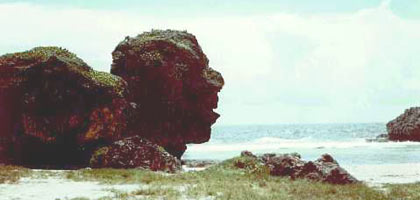

| the expedition | |
| the science | |
| tools & techniques | |
| daily journal | |
| the team | |
| questions & answers | |
|
the islands Saipan Anatahan Sarigan Guguan Alamagan Pagan Agrigan Asuncion Maug Uracas |
|
|||||||||||||||||||||||||||||||||||||||||||||||||||||||||||||||
The Spanish

The Mariana Islands went by at least two other names before their current name was bestowed upon them. Upon his first unpleasant encounter with the Chamorro, Ferdinand Magellan decided to name them for a second time, calling them "Las Islas de los Ladrones," ("The Islands of the Thieves").
The first contact took in Guam's Umatac Bay. Not only was this the first meeting of a Westerner and the Chamorro but the first between the West and any of Oceania's indigenous peoples. Tired and bedraggled after three months at sea, the crews of Magellan's ships hoped to assemble a landing party to gather what provisions it could find on the islands.

Before they reached land, however, the excited Chamorro met them in the bay. It turned out the warriors were less interested in meeting these strange new peoples as in helping themselves to the possessions they brought with them. The warriors boarded the ships and began taking what they could, having a comparatively liberal concept of ownership. The weakened Spanish sailors were only able to fend off the Chamorro after firing a few warning shots that sent the warriors retreating back to land.
Magellan was eventually able to get some fruit and vegetables in return. He would set out again and the place he noted on his map would be formally claimed by the Spanish Crown in 1565. A century later, Western occupation would begin in earnest.
It began in 1668, when a contingent of Jesuit missionaries, led by Padre Diego Luis de San Vitores, arrived at the islands. San Vitores gave the archipelago its modern name after Mariana of Austria, the widow of Spain's Philip IV. The band of missionaries were interested in conversions; the Spanish government was interested in fortifying the trade routes traversed by galleons.
The high-ranking male of the Chamorro community on Guam, Chief Kepuha, originally welcomed San Vitores and even allowed himself to be baptized. San Vitores constructed the first church on the island in 1669 with the blessing of the chief and high-ranking females of the island, who were the only ones who could inherit and give land.
The initial goodwill was short-lived. The Spanish set about Westernizing the Chamorro, teaching them to raise corn, tend cattle and to adopt Western clothing. Many Chamorro chafed at the intrusion. Their discontent culminated in the killing of San Vitores by a Chamorro chief incensed that the priest had baptized his infant daughter without his consent.
That set off decades of skirmishes between the Chamorro and the Spanish. The ensuing fighting - along with introduced diseases, would nearly wipe out the Chamorro. From an estimated population of 150,000 prior to annexation to the Spanish Crown, their number dropped to less than 5,000 by 1741.
In 1740, the Spanish began consolidating the population to facilitate conversion and control. Soldiers forced many of the Chamorro to relocate from the northern Mariana Islands to Guam. Many of the natives, especially on the island of Rota, successfully hid out in the hills there. To this day, the inhabitants of Rota remain the least ethnically mixed of the Chamorro population in the Marianas.
Spanish and Filipino settlers moved to the Mariana islands to repopulate them. Starting in 1815, natives of the Caroline Islands to the southwest of the archipelago began occupying the northern Marianas. It would not be until 1885, toward the end of Spain's reign over the Marianas, that the now Hispanicized Chamorro were encouraged to return to the northern islands. By that time, the Carolinians had taken over many of the most desirable lands there.
